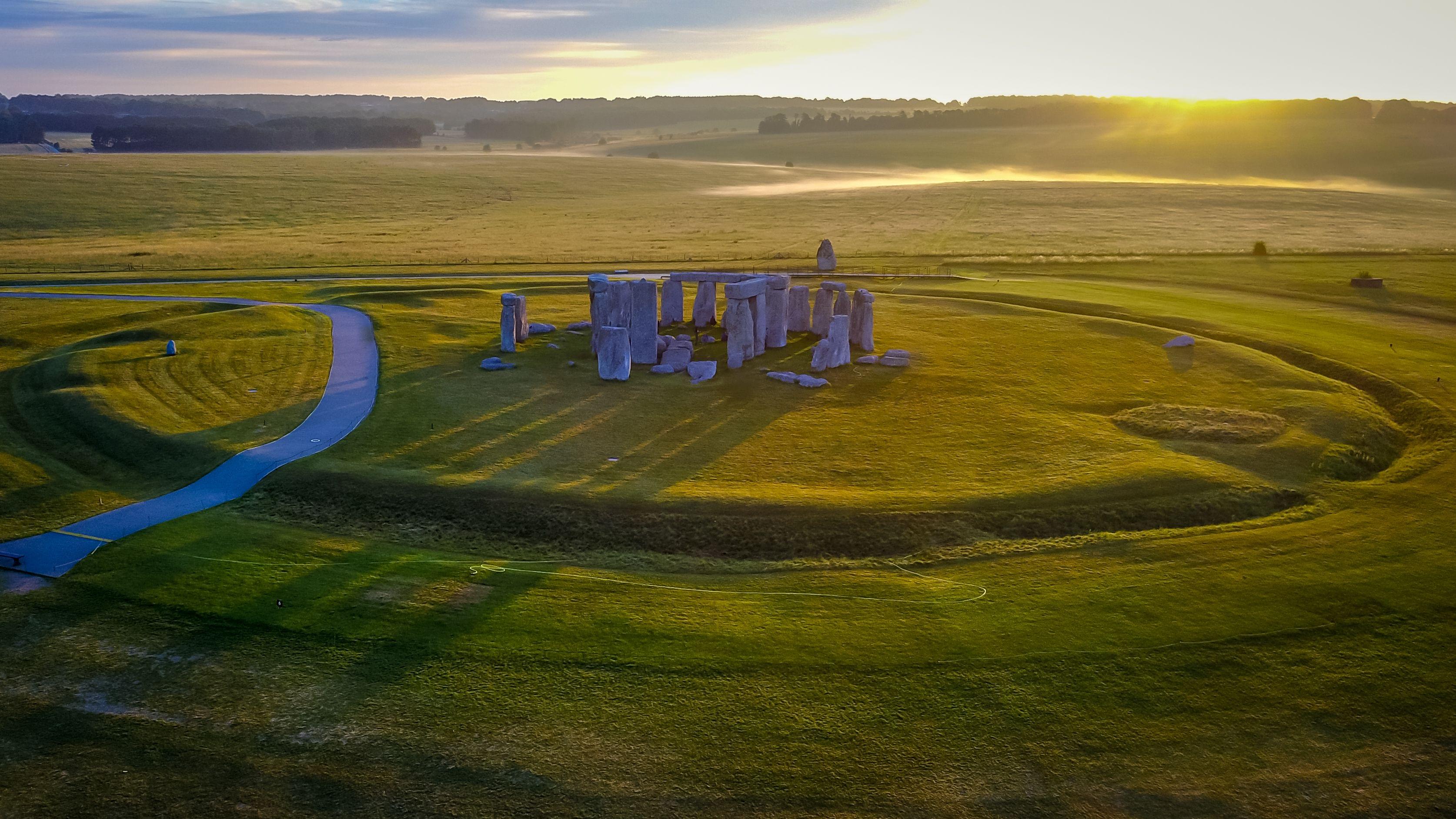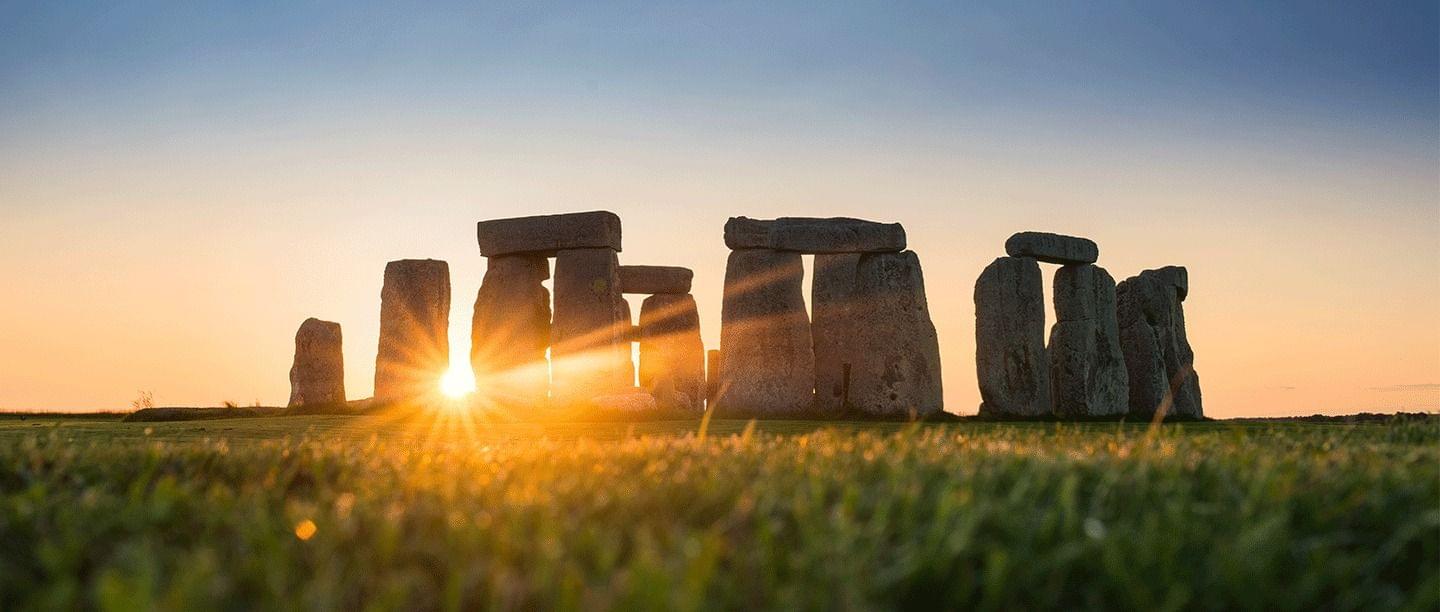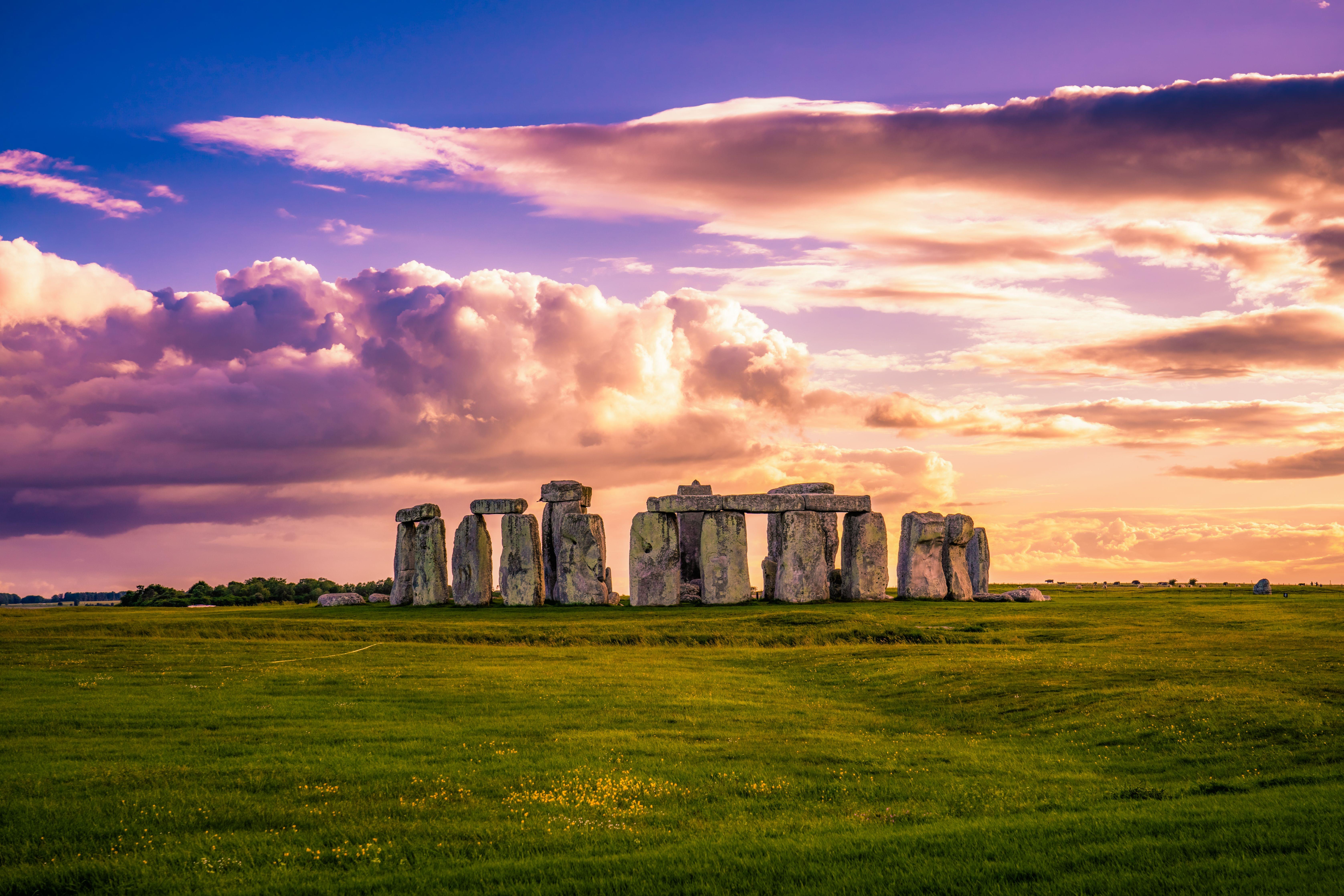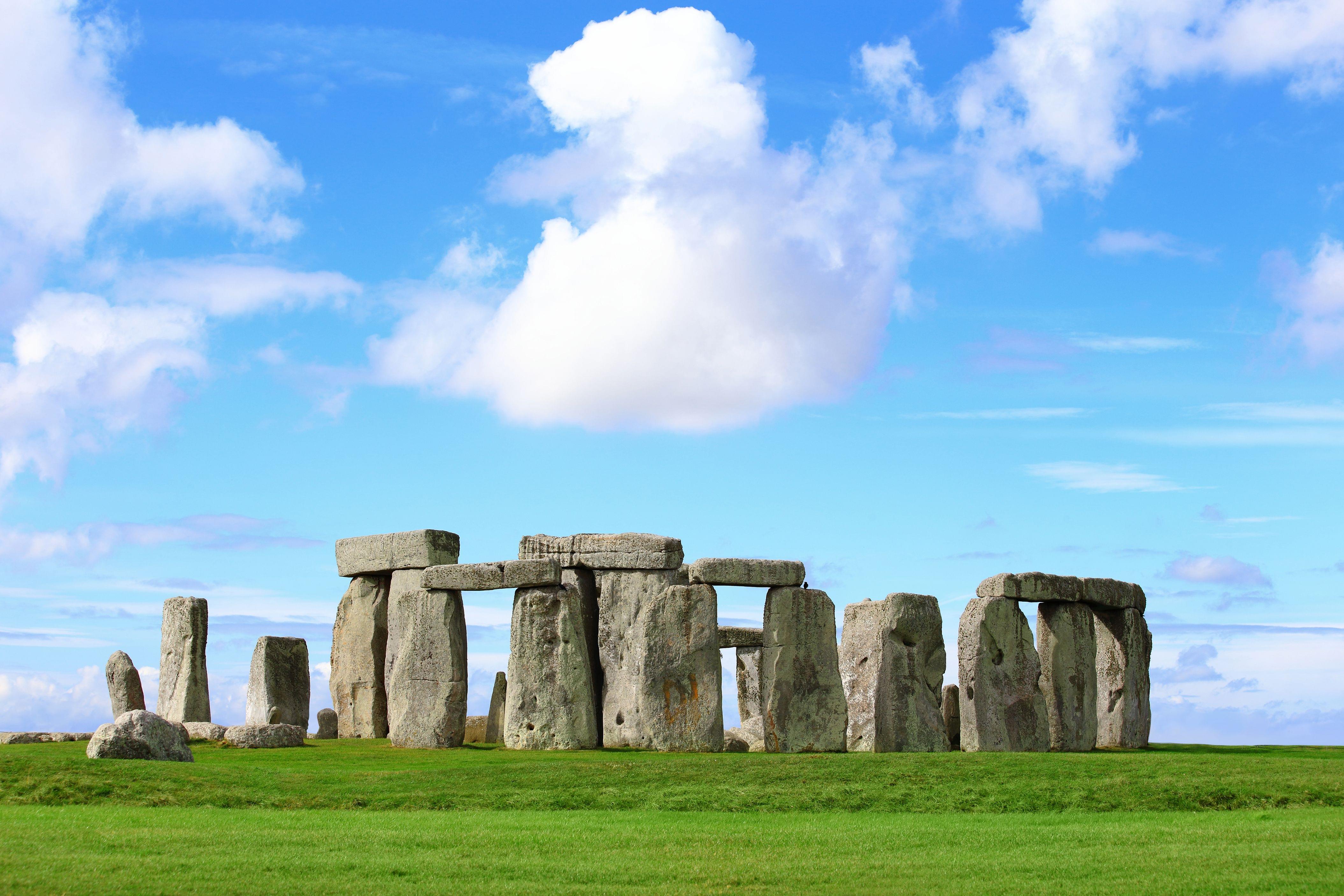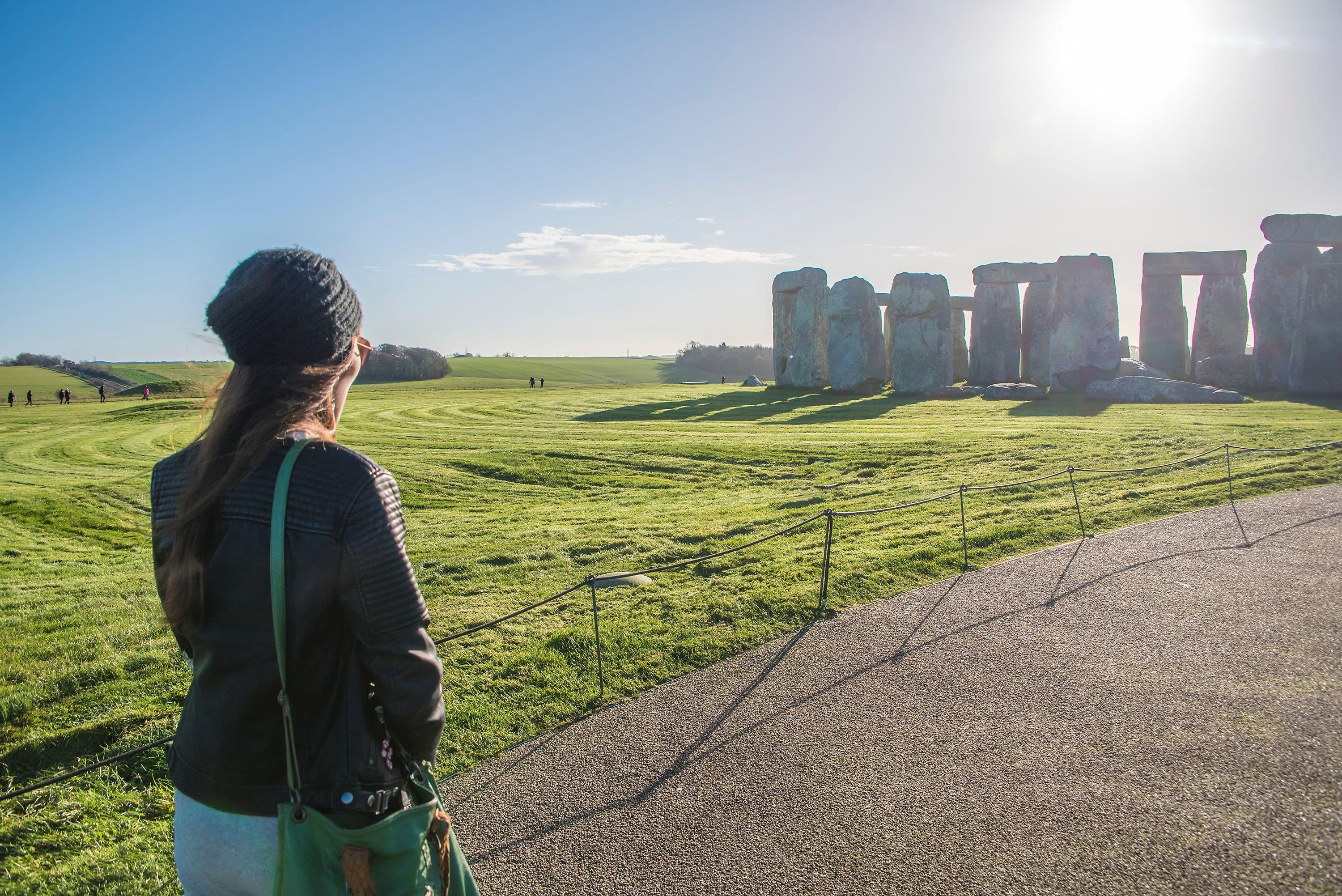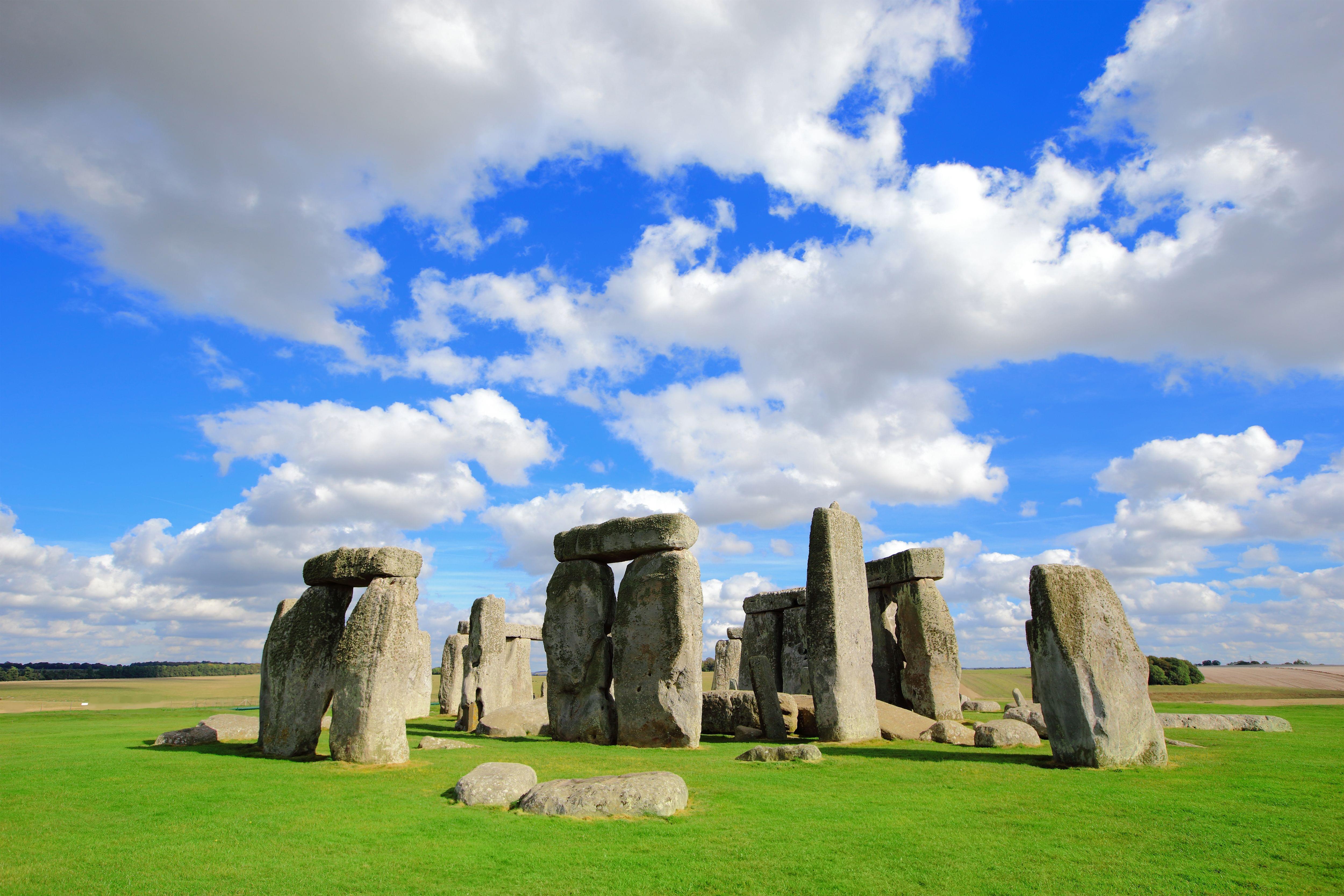Discover Stonehenge: An Iconic UNESCO World Heritage Site
Book Stonehenge Tickets & Tours
Explore the captivating mysteries and legends that surround Stonehenge, a site steeped in intrigue
Take in the breathtaking beauty of the Salisbury Plain, providing a stunning backdrop to the ancient site
Enhance your experience with an informative audio guide, providing fascinating insights and historical context
Book your Stonhenge tickets and capture the magic of the moment as you witness the iconic silhouette of this iconic attraction
- The schedule is subject to change depending on traffic and weather conditions on your activity date.
- Please dress accordingly depending on the day's weather conditions.
- Arrive at the meet-up location 15 minutes before the scheduled activity time.
- Latecomers or no-shows can't be refunded.
- Make sure to arrive on time.
- The tour bus will leave sharply on time.
- All foreign nationals must share their passport and visa details at the time of arrival.
- Last admission is 2 hours before closing.
- Service dogs are welcome.
Explore the captivating mysteries and legends that surround Stonehenge, a site steeped in intrigue
Take in the breathtaking beauty of the Salisbury Plain, providing a stunning backdrop to the ancient site
Enhance your experience with an informative audio guide, providing fascinating insights and historical context
Book your Stonhenge tickets and capture the magic of the moment as you witness the iconic silhouette of this iconic attraction
- The schedule is subject to change depending on traffic and weather conditions on your activity date.
- Please dress accordingly depending on the day's weather conditions.
- Arrive at the meet-up location 15 minutes before the scheduled activity time.
- Latecomers or no-shows can't be refunded.
- Make sure to arrive on time.
- The tour bus will leave sharply on time.
- All foreign nationals must share their passport and visa details at the time of arrival.
- Last admission is 2 hours before closing.
- Service dogs are welcome.
Book Windsor, Stonehenge And Oxford Tour From London
Take a tour of the largest occupied fortress in the world for over 900 years: the Windsor Castle
Get insights about the mysterious architecture of stone circle- Stonehenge
Explore the famous university city- Oxford, also known as "The City of Dreaming Spires"
Learn historical and cultural facts about London and these buildings by an English-speaking guide
Visit 3 iconic attractions of London- Windsor, Stonehenge & Oxford in a whistle-stop city tour
- Windsor Castle is closed on Tuesdays and Wednesdays.
- As a working royal palace, the castle is used frequently by the Queen for state ceremonies and official entertaining. Therefore, opening arrangements may change with no notice.
- The order in which the attractions are visited may vary seasonally or for operational reasons.
- Travel time back to London (approximately 2 hours) can vary with traffic congestion an unknown variable. Please be mindful of this when making post-trip arrangements.
- Viewing at Windsor Castle is restricted on Sundays. Also, St George's Chapel is closed to visitors on this day.
- Fixed day ticket implies that this ticket will be applicable only for the date that you've booked the ticket, it won't be carried forward to next or any other day.
- Children aged 0-2 years can join free of cost. Child Tickets are applicable for visitors aged 3-16 years. Adult Tickets are applicable for visitors aged 17-65 years. Senior Tickets are applicable for visitors aged 65-99 years.
- Entrance tickets to the attractions and any other personal expenses are not included in the package.
- All foreign nationals must share their passport and visa details at the time of arrival and entry.
Take a tour of the largest occupied fortress in the world for over 900 years: the Windsor Castle
Get insights about the mysterious architecture of stone circle- Stonehenge
Explore the famous university city- Oxford, also known as "The City of Dreaming Spires"
Learn historical and cultural facts about London and these buildings by an English-speaking guide
Visit 3 iconic attractions of London- Windsor, Stonehenge & Oxford in a whistle-stop city tour
- Windsor Castle is closed on Tuesdays and Wednesdays.
- As a working royal palace, the castle is used frequently by the Queen for state ceremonies and official entertaining. Therefore, opening arrangements may change with no notice.
- The order in which the attractions are visited may vary seasonally or for operational reasons.
- Travel time back to London (approximately 2 hours) can vary with traffic congestion an unknown variable. Please be mindful of this when making post-trip arrangements.
- Viewing at Windsor Castle is restricted on Sundays. Also, St George's Chapel is closed to visitors on this day.
- Fixed day ticket implies that this ticket will be applicable only for the date that you've booked the ticket, it won't be carried forward to next or any other day.
- Children aged 0-2 years can join free of cost. Child Tickets are applicable for visitors aged 3-16 years. Adult Tickets are applicable for visitors aged 17-65 years. Senior Tickets are applicable for visitors aged 65-99 years.
- Entrance tickets to the attractions and any other personal expenses are not included in the package.
- All foreign nationals must share their passport and visa details at the time of arrival and entry.
Take a tour of the largest occupied fortress in the world for over 900 years: the Windsor Castle
Get insights about the mysterious architecture of stone circle- Stonehenge
Explore the famous university city- Oxford, also known as "The City of Dreaming Spires"
Learn historical and cultural facts about London and these buildings by an English-speaking guide
Visit 3 iconic attractions of London- Windsor, Stonehenge & Oxford in a whistle-stop city tour
- Windsor Castle is closed on Tuesdays and Wednesdays.
- As a working royal palace, the castle is used frequently by the Queen for state ceremonies and official entertaining. Therefore, opening arrangements may change with no notice.
- The order in which the attractions are visited may vary seasonally or for operational reasons.
- Travel time back to London (approximately 2 hours) can vary with traffic congestion an unknown variable. Please be mindful of this when making post-trip arrangements.
- Viewing at Windsor Castle is restricted on Sundays. Also, St George's Chapel is closed to visitors on this day.
- Fixed day ticket implies that this ticket will be applicable only for the date that you've booked the ticket, it won't be carried forward to next or any other day.
- Children aged 0-2 years can join free of cost. Child Tickets are applicable for visitors aged 3-16 years. Adult Tickets are applicable for visitors aged 17-65 years. Senior Tickets are applicable for visitors aged 65-99 years.
- Entrance tickets to the attractions and any other personal expenses are not included in the package.
- All foreign nationals must share their passport and visa details at the time of arrival and entry.
Why to Book Stonehenge Tickets Online?
Stonehenge Ticket Options
When you embark on guided Stonehenge tours, you're signing up for a comprehensive experience. An expert guide will accompany you, offering valuable insights, historical backgrounds, and captivating stories of the monument. With a standard ticket, this insightful tour isn't included, but it's worth the investment. Not only are you enlightened by the guide, but transportation logistics are also managed, making your trip seamless. And if you’re on the hunt for a discount on the tickets, opting for guided tours might land you some deals.
For those who prefer a sense of freedom in exploration, non-guided tours of Stonehenge might be your fit. Your Stonehenge tickets grant you entrance, but the path you tread and the pace you set is yours to decide. Stonehenge also provides a downloadable audio guide, which becomes a valuable companion, offering titbits and facts as you navigate the site. However, make sure you've got your transport to and from the iconic site sorted as this isn't part of the package.
Also Checkout: IFS Cloud Cable Car
Diversity is key when it comes to Stonehenge tours. Some visitors prefer the ease of tours with transfers included in their Stonehenge entrance tickets. These options save time, especially beneficial if you're tight on schedule or unfamiliar with the local transportation system. A bus often awaits, ready to transport you to the mesmerising stone circle and back. However, if you're the kind of traveller who seeks adventure in the journey itself, then tours without transfers might appeal. You'll have the liberty to chart your path, maybe even stopping at hidden gems along the way.
For travellers eager to immerse themselves in more than just the Stonehenge experience, combo Stonehenge tours are the ideal pick. These packages provide a holistic experience, allowing you to explore neighbouring attractions like Windsor, Bath or even the academic hubs of Cambridge. With most combo tours, you'll find a guide and transportation part of the package. You might also be able to save some money with an exciting Stonehenge tickets discount. So, not only do you discover the mysteries of Stonehenge, but you also venture beyond, diving deeper into England's rich heritage.
Stonehenge Tours
For those based in London, the Stonehenge tours are a enticing glimpse into ancient history just a short journey away. You can embark on a comfortable coach ride, typically taking around two hours, weaving through England's scenic countryside. Along the way, many tours offer audio narratives, ensuring that by the time you step onto the iconic site, you're brimming with anticipation and knowledge. With Stonehenge tours from London, the capital's urban hustle fades, replaced by the mysteries of a bygone era.
Bath, known for its Roman-built baths, also serves as a gateway to the enigmatic Stonehenge. Stonehenge tours from Bath are a treat, combining two UNESCO World Heritage Sites in a single journey. You can enjoy a shorter commute than from London, often taking just an hour. This proximity allows more flexibility in tour timings and the potential for sunset or sunrise visits. Blending the elegance of Bath's Georgian architecture with the Neolithic splendour of Stonehenge creates an unforgettable experience.
A mere 15 kilometres away, Salisbury offers the closest and most intimate tours of Stonehenge. The journey is a breeze, often around 20 minutes, granting you ample time to immerse yourself in Stonehenge's aura. After your visit, you can head back to Salisbury to explore its historic streets and traditional eateries, making it a comprehensive day out. The mediaeval charm of Salisbury, with its majestic cathedral, seamlessly complements the ancient allure of Stonehenge. These tours are perfect for those who want to delve deep into history without spending much time on the road.
History of Stonehenge
When availing the Stonehenge tickets, you can also learn about its history. The earliest signs of human activity near the iconic Stonehenge site date back to the Mesolithic period, between 8500-7000 BC. It's believed that the initial structures in this area included pits, some of which show evidence of having held tall wooden posts. Although Stonehenge's creation occurred between the Neolithic Age and Bronze Age, around 3000-2000 BC, its origins remain a mystery without any written records.
Stonehenge's roots can be traced back to around 3000 BC when significant structures like the Heel Stone and the North Barrow emerged. However, the most notable early construction was a circular ditch with internal and external banks, housing about 56 pits known as the Aubrey Holes. Initially considered an early henge monument, debate persists over the purpose of these holes, though many believe they supported timber poles. Interestingly, while Druids were once believed to have constructed Stonehenge, radiocarbon dating debunked this theory, as Stonehenge pre-dated their presence. Early Neolithic agrarians are believed to have pioneered its construction, with succeeding contributors remaining unidentified.
Stonehenge's most captivating features undoubtedly are its stone settings. Classified primarily as sarsens (larger rocks) and bluestones (smaller ones), these stones were arranged meticulously. The sarsen circles came in two forms: an inner horseshoe and an outer circle. Bluestones adorned these sarsen formations, arranged in a double arc. The sarsens, originating from Marlborough Downs, located 32 kilometres away, stood impressively, with the Heel Stone being the heaviest. The bluestones, bearing a distinctive blue shade when wet, were sourced from the Preseli Hills in Wales. Their transportation method to Salisbury Plain remains a mystery, with theories ranging from glacial movements to human endeavours.
Following its construction, Stonehenge transformed into a nexus for ceremonial and ritualistic activities. Over the ages, it witnessed gatherings for significant religious and social events, such as burials and marriages. As eras passed, modifications to Stonehenge were frequent. Bluestones underwent repositioning, and new stones were integrated. Some found their place in specially excavated holes, while others were elevated into diverse formations. In tandem with its spiritual prominence, Stonehenge began to play a role in the socio-political dynamics of the region, potentially serving as a convergence point for tribal leaders and communities.
Stonehenge's significance persisted for centuries. Around 700 BC, during the Iron Age, it attracted pilgrims paying homage to ancestors buried in its vicinity. Subsequent Roman occupation of Britain saw Stonehenge referenced in various works, and excavations have unearthed numerous Roman artefacts at the site. The Middle Ages further elevated Stonehenge's spiritual importance, cementing its position as a cultural landmark. Various chronicles and manuscripts from the mediaeval era make mention of Stonehenge, alluding to its awe-inspiring presence and its role as a bridge connecting the present to a distant, enigmatic past.
As the 20th century dawned, Stonehenge's surrounding areas experienced militarization. This led to numerous infrastructural changes, with the introduction of barracks, airfields, and other structures during World War I. While many have since been razed, remnants of these structures like the Larkhill airfield sheds still stand. Modern times have seen concerted efforts towards Stonehenge's conservation, with protective measures ensuring its legacy for future generations. For those considering a visit, securing tickets to Stonehenge has never been more crucial to witness this enduring testament to ancient civilizations.
Types Of Stones In Stonehenge
While securing your Stonehenge tickets, the awe-inspiring Heel Stone, often referenced as Stone 96 or The Friar’s Heel, should top your list. This mammoth unshaped sarsen stone, weighing over 36 tonnes, is unique in its placement, surrounded by a subtle circular ditch. This sarsen marvel marks the precise point where the summer solstice sun rises annually, a spectacle many crave to witness. While you're there, imagine another similar-sized stone, its partner, which archaeologists believe once stood beside it, framing the entrance to this ancient wonder. It's not just a stone; it's a time capsule of celestial importance.
As you get your tickets to Stonehenge, don't miss the architectural finesse of the lintels. Of the original outer sarsen circle, only six lintels remain, interlocking meticulously with the upright sarsens. What's fascinating is how these stones, massive and sturdy, were connected using techniques reminiscent of woodworking. The mortise and tenon, along with tongue and groove joints, demonstrate the sophistication of Stonehenge builders. Moreover, the meticulous levelling and positioning of these lintels amplify the illusion of a continuous ring, defying the very terrain they stand upon.
Surrounding the central monument, Station Stones form a strategic rectangle and hold their own mysteries. Only two remain of the original four, yet they hold immense significance. There are markers indicating where the ruined counterparts once stood, mirroring the monument’s solstice as well as lunar alignments. They create a geometrically precise rectangle around Stonehenge, emphasizing the astronomical knowledge and importance imbued within. So, the next time you're pondering over tickets for Stonehenge, remember the Station Stones and the astronomical tales they might tell.
Stone 52, with its rich history, is a canvas bearing tales from the past. The enigmatic 'I WREN' graffiti etched onto it stirs intrigue, and is potentially attributed to Sir Christopher Wren, the mastermind and acclaimed architect behind St. Paul’s Cathedral. While history remains uncertain, this stone stands as a testament to the many who've been enamoured by Stonehenge's allure. This stone reminds visitors of the countless interactions and stories, both ancient and new, that the monument has inspired.
A visit to Stonehenge wouldn't be complete without witnessing the Slaughter Stone. Named by Victorians with vivid imaginations, this gigantic stone evokes tales of ancient rituals. Now lying horizontally, it was once vertically positioned right at the entrance of Stonehenge. Its surface, marked by shallow crevices, collects rain, which, when reacting with the stone's iron, turns a captivating rusty red in colour. This phenomenon stirred beliefs of it being stained from ancient sacrifices, a myth adding to the allure of Stonehenge.
While securing your Stonehenge tickets, you will also encounter the sarsens, which are undeniably a highlight of this monument. Originally, a grand circle of 30 upright sarsens stood tall, crowned by meticulously shaped lintels. Originating from Marlborough Downs, these sarsens, especially Stone 160, when freshly carved, would have shimmered brighter than the grey relics you see today. These stones serve as reminders of the lengths ancient civilizations went to, transporting them vast distances, in their quest to commune with the cosmos.
Stone 56's grand stature, towering above the others, is hard to miss. As the only survivor of the tallest trilithon in the inner horseshow, it bears mortice holes and a prominent tenon, pointing to a bygone partner and lintel. Its vertical side was masterfully designed, possibly as a viewing slot for the winter solstice sunset. This stone silently speaks of lost companions and the undying spirit of ancient architects to align with celestial events.
Among the many mysteries you can witness when buying your tickets to Stonehenge is Stone 68, bearing a unique trait, suggesting it was once part of a larger structure. Brought from the distant Preseli Hills in Wales, it is one of the 80 bluestones that hold tales of ancient relocations and repurposing. Stone 68's design hints at a past where it had a double-width structure or stood joined to another stone, perhaps in a different configuration, adding layers to Stonehenge's enigmatic history. It also links Stonehenge to ancient Wales.
As your tour of Stonehenge comes to an end, do not forget to marvel at Stone 53. This is an upright of the trilithon, and offers glimpses of a Bronze Age past. Professor Atkinson's discovery of dagger and axe blade carvings on this stone in 1953 will surely transport you back in time. These carvings, dated between 1750 and 1500 BC, after Stonehenge’s primary construction, tell stories of a dynamic monument, evolving and interacting with generations across millennia. Every etch and mark stands as a testament to the monument's enduring significance.
Experiences at Stonehenge
Stonehenge England is a marvelous construction surrounded by breathtaking landscapes of lush green plains. While visiting, guests get a chance to take it all in with a 360 degree view of the stones and the history from the Visitors centre. Learn about the history, significance and purpose of these stones in history from the expert guide and a beautiful presentation. As the seasons pass and time turns back, visitors are taken on a journey to the inside of the circle and witness its beauty on the virtual screen. This visual treat really helps the guests get a more clear understanding of the design and structural composition of the stone circle.
You May Also Book: London Attraction Tickets
The Stone Circle is one of the most amazing and unique structures to be known to mankind. Built in the prehistoric era, this structure creates a mystery and intrigue regarding its construction and purpose. The tall large stones are built of Sarsen Sandstone and form the main circle. Surrounding these are smaller structures built of various small stones known as the 'Bluestones'. The simple yet evidently complicated structure leaves visitors in awe of its design and calming vibe. The site is even more mesmerizing during the sunsets, as the sky above turns into a beautiful canvas of different colors.
Must Checkout: London To Stonehenge
Nestled near the Visitors centre, the Neolithic Houses are built out of stone and hay. These structures are a stunning representative of houses in the prehistoric age and give the visitors insight into the life of men during the period. Inside the house there is a single spacious airy room with white chalk walls and a reflective floor to reflect the sun rays and store the warmth. From watching volunteers demonstrate the day to day chores of the people of that age to doing them yourself, this is one of a kind experience for guests during the Stonehenge tour.
Do Checkout: Campsites Near Stonehenge
Stonehenge Solstice
The Summer Solstice is celebrated as a grand festival at Stonehenge, England. The sun comes up from behind the Heel Stone on each summer solstice, around June 21, and the first rays fall through the centre of Stonehenge. The summer solstice festival is based on the belief that the day is celebrated at Stonehenge for thousands of years. Tens of thousands of people gather at the stone circle and watch the beautiful event as the sun rays from the clear sky evidently mark the beginning of a new phase on the longest day of the year.
Do Checkout: Bath To Stonehenge
The winter solstice too marks the turning of the year, as the year's longest night comes to an end. Thousands of people gather at Stonehenge England to celebrate the increasing warmth that will be accompanied by longer days in the next phase of the year. Even though the tallest stone does not stand upright any more, the sun would fall between the tiny gap of the upright stones during a winter solstice. The Neolithic people were mostly farmers, and to them this day meant the end of long cold nights and coming of bright warm days. Therefore it was celebrated with joy and vibrant gatherings, which is now miniced by the druids and pagans as well as other people from around the globe.
Also Explore: Things To Do Near Stonehenge
Stonehenge Exhibitions
The Circles of Stone exhibition is a testament to the enduring human spirit, connecting distant dots on a global historical map by linking the prehistoric cultures of Britain and Japan. As you navigate this space, you'll encounter exquisite artefacts illuminating the middle and late Jomon period's Japanese settlements and stone circles. Despite the geographical differences between Britain and Japan, the exhibition reveals startling parallels. Their shared legacy emerges in stone circle constructions, ritualistic practices, and the pivotal role of stone tools in their respective histories.
Must Checkout: Oxford To Stonehenge
The Henry Moore Sharing Form Exhibitions, hosted in spring 2022, will depict the work of famous artist Henry Moore. Spanning over six decades of artwork, the collection will be on display in 5 galleries, and also feature a small open air presentation of the seminal works. The exhibition is a display of the fascination that Moore had with these upright standing structures under the beautiful sky, wrapped in a deep mystery. From his early artwork of the Stonehenge to later periods of research and understanding the relation of this structure with its surroundings, everything will be open for visitors to explore and admire.
You May Also Like: Brighton To Stonehenge
Hosted by the British museum, this iconic exhibition tells the tales of the prehistoric times on the continent of Europe. The focus of this exhibition is the iconic stone circle monument, a Neolithic structure standing with pride. In addition to this, the exhibition also talks about the Mesolithic age, or the Bronze age. Various fascinating objects of different periods are on display, such as green stone axes from the Italian Alps, the Nebra sky disc originating from Germany and much more. Visitors learn a lot about Stonehenge with the entire history of Europe as its background, and how this iconic structure has been a part of it through ages.
The Your Stonehenge exhibition features the pictures of visitors or pictures taken by the visitors over the past 150 years. A beautiful recollection of how times have changed but this majestic landmark still stands strong, the exhibit is open daily at the visitors center of Stonehenge. It also reflects upon how the lives of mankind have changed and evolved along this passing time. From monochrome to color pictures, visitors will find all sorts of fascinating shots that are a mirror to the history of this beautiful lush landscape. Some of these pictures are of people who used to live around the site, while some pictures belong to visitors from decades ago.
The Stonehenge exhibition is akin to opening a time capsule. Every artefact, from the 5,500-year-old reconstructed face to the ancient tools, whispers tales of eras gone by. Here, England’s legacy unfolds, as over 250 archaeological treasures chart its journey. The meticulously detailed pottery, gleaming jewellery, and ancient tools bear silent testimony to time's passage. Enhanced by cutting-edge audio-visual aids, the exhibition paints a vivid tableau of Stonehenge's lore. And for returning visitors, the centre's specialised exhibitions promise fresh insights, making memories anew.
Your quest for knowledge deepens at the visitor's centre, accessible with a special Stonehenge tickets price, and showcasing a plethora of prehistoric artefacts related to the Stonehenge World Heritage Site. Many items, including intricate pottery and gleaming jewellery, are graciously loaned by Salisbury Museum and Wiltshire Museum. Highlights include the Neolithic-era 'Arrowheads' and the intriguing 'Mandible' jaw bone, discovered nestled at the Stonehenge ditch's base. For those whose curiosity knows no bounds, Stonehenge's partner museums are a must, offering deeper insights into this bygone epoch.
Beyond the mystique of Stonehenge, the partner museums - Salisbury Museum and Wiltshire Museum - invite you to explore the broader context of the prehistoric era. Delve into the heart of this ancient world, enriched by diverse art, history, and archaeology exhibits and artefacts. The Salisbury Museum captivates with its myriad courses, tours, and displays, immersing visitors in the Stonehenge narrative. At Wiltshire Museum, interactive galleries await, where the Stonehenge era's golden treasures shimmer, reminding you to secure your tickets for Stonehenge.
Gnomus At Stonehenge
- Gnomus's story is that of a friendly giant who used to live even way before the Stonehenge was constructed, and has returned to check upon the magnificent structure.
- This 4 meter tall animated puppet is as tall as the Sarene Sandstones and features in many shows from 10 AM - 5 PM at the World Heritage Site.
- The giant is believed to be the caretaker of the earth and guardian of all wildlife, who has looked before it since the beginning of time.
- Telling various history and Stonehenge facts in a creative manner, in the form of stories, Gnomus creates a kid friendly environment and is even loved by the adults.
- The interactive performances also focus on environmental preservation and how all humans should become the caretaker of the earth.
Know Before You Book Stonehenge Tickets
Location: Near Amesbury, Wiltshire, SP4 7DE
Opening Hours: All days of the week from 9:30 AM - 7:00 PM
*During Solstice the time varied in accordance with the celebration/festival at Stonehenge.
Best Time To Visit: Even though this place is ideal for visiting any time of the year, the months from June to September are the best for planning a visit to Stonehenge. These months witness pleasant weather as compared to the colder winters. Do keep in mind that these seasons also are peak durations and you will find a rush at the site and on the tickets counter. So it's best to plan ahead while visiting that time and book your Stonehenge tour in advance.
By Car: Stonehenge is clearly signposted by route A303 and is on route A360. Visitors can hire a rental car if they are not travelling by themselves. It takes around 2 hours to reach Stonehenge from London via road.
By Bus: The Victoria Coach Station has scheduled buses travelling between London and Stonehenge. The bus station at Salisbury is a walking distance from the tourist spot. The best option to choose is to take the London to Stonehenge shuttle bus from Victoria Coach Station as it drops visitors directly at Stonehenge.
By Train: Visitors can take the train that stops at Salisbury station, from where it is 18 minutes of travel. Visitors can take the Salisbury red bus to travel to Stonehenge Visitor's centre from the station or any other local transport service.
- It is best to book your Stonehenge Tickets online in advance to avoid wait lines and rush during peak seasons for tourists.
- Pets are not allowed at Stonehenge, unless it's a service animal and that is the only exception.
- Do visit all the ongoing exhibitions during the Stonehenge tour to understand the history and significance of the stone circle, surrounding landscapes and its elements.
- Differently abled people or those who require extra care and attention are allowed to bring along one more companion for free.
- For the winter season keep in mind the chilly weather as you decide on your outfit for the day and add as many layers as possible.
- Stonehenge tickets include access roughly upto 15 yards of the stone circle. However, separate Stonehenge tours are conducted in additional time slots for visiting inside the Stone circle.
Also Checkout: Hotels Near Stonehenge
- The Stonehenge has a cafe for visitors to enjoy delectable meals between their tour of the pre-historic landmark.
- A dedicated picnic area is marked for visitors to enjoy the open plains.
- Parking facility is available for visitors on the site.
- The Stonehenge gift shop has a wide selection of books, gifts, and keepsakes, such as jewellery and a limited edition items of Barbour apparels and accessories.
- Male and Female washrooms are available with accessible baby changing facilities at the Visitor centre.
- Free audio Stonehenge tours are accessible at the official app, available on different platforms.
Also Checkout: Things To Do In Stonehenge
FAQ's
Do I have to book Stonehenge tickets in advance?
While it is not necessary, booking Stonehenge tickets in advance is a smart move. This way, you will secure your entry at the exact time you desire, avoiding the disappointment of missed opportunities. Stonehenge is a world-renowned attraction, often drawing large crowds. By reserving your slot beforehand, you ensure a seamless experience. Additionally, you might also be able to enjoy Stonehenge tickets discount, thereby saving some money.
Can I choose my preferred time slot while booking Stonehenge tickets?
Yes, you can indeed choose a time slot of your preference while booking your Stonehenge tickets online. You can handpick your desired date and time up to a mere three hours before the visit. Although on-the-spot tickets are an option at Stonehenge, availability might be a gamble. Pre-booking, on the other hand, assures you a guaranteed entry, aligned perfectly with your schedule.
How long does it take to get from the Visitor’s Centre to the Stone Circle?
If you have opted for the shuttle bus, a mere ten-minute ride will land you at the Stone Circle. This option primarily serves those with mobility concerns or elderly visitors. On the other hand, if you wish to walk from the Visitor’s Centre to the Stone Circle, it will take you anywhere between 20 to 40 minutes, depending upon your pace.
How much time do you need for Stonehenge tour?
The time duration needed for the Stonehenge tour totally depends on the time of the day you are visiting and also how the rush is on that particular day. However, it's mostly suggested to take at least 2 hours to explore the mysterious landmark and its surroundings. Also, if you want to click more pictures and spend a relaxing time, be sure to take out more time from your day.
Who built Stonehenge?
There is no record of who built the Stonehenge, but it is believed by most modern archeologists that it was built by different tribes of different periods over time. However, some still believe that the construction was a magical miracle by Merlin. Theories also suggest that the landmark might have been constructed by the Danes, Saxons, Romans, Greeks or Egyptians.
What is Stonehenge made of?
It has been discovered by archeologists and scientists in recent times that the Stonehenge is made of two main stones of different kinds. The stones that are currently part of the major construction of the historical landmark are: Sarsen Sandstone and the 'Bluestones'. The Sarsen Sandstones are used in the massive upright stones which are capped by horizontal lintels. The 'Bluestones' are actually a collective mix of igneous rocks and sandstones smaller in size placed in the central area, forming the smaller parts.
What was Stonehenge used for?
Over the years archeologists and scientists from around the world have put forward plenty of theories about what Stonehenge was used for. One of the most popular and validated theories is that Stonehenge was used as a burial ground for the royalty or maybe even the common people of the community. Another popular theory was that Stonehenge served as a major astronomical calendar or a place of healing. Or maybe over the years this popular landmark has served many purposes and each theory is equally valid.
What is the history of Stonehenge?
The Stonehenge construction was started around 5000 years ago in the Neolithic age. Over the years, many parts were added to it by different tribes of different periods. Brimming in mystery and set in the surroundings of a beautiful landscape, the Stonehenge is an enchanting tourist spot. It is believed that Stonehenge might have been completed at some point and after that it was partially destroyed during the later periods.
Why is Stonehenge so famous?
Stonehenge's allure lies in its enigmatic origin and astral alignments, mesmerising visitors with tales of druids and ancient ceremonies. This prehistoric monument, cloaked in centuries-old mysteries, stands as an enduring symbol of Britain's ancient past. Its massive stones, transported from afar, are silent witnesses to bygone eras, inviting awe and endless fascination from all who approach. Stonehenge remains an unmatched relic, capturing imaginations worldwide. All of this also makes Stonehenge a significant symbol of the ancient world and a UNESCO World Heritage Site.
How long does a Stonehenge tour from London take?
If you have booked just the monument with your tickets for Stonehenge from London, it will take you around 6 hours. This time covers the drive to Stonehenge and back, plus the time you spend exploring the iconic stones. The journey itself offers glimpses of England's picturesque landscapes, enhancing the experience. Additionally, the guided tours at Stonehenge provide invaluable insights, ensuring that the time spent is both educational and awe-inspiring.
How much time should I spend in Stonehenge?
For a comprehensive experience at Stonehenge, you must ideally spend around 2 to 3 hours here. This period offers a deep dive into its enigmatic aura and history. However, the beauty of Stonehenge is its timelessness, so feel free to extend your stay, letting personal curiosity be your guide. Your visit's pace is yours to set, ensuring a truly personalised exploration.
When was Stonehenge built?
Stonehenge, an iconic monument, was built between 3000 and 2000 BC, during the transition from the Neolithic Age to the Bronze Age. While the absence of written records cloaks its origins in an enigma, diligent research over time has revealed fragments of its intriguing history. This ancient marvel stands as a testament to bygone eras, drawing visitors into its captivating aura of mysteries.
What are Stonehenge opening hours?
Stonehenge welcomes visitors with varying hours depending on the season. In the quieter months of January to March and November to December, it is open from 09:30 a.m. to 05:00 p.m. As the days grow longer in April, May, September, and October, the gates stay open from 09:00 a.m. to 07:00 p.m. But for those wanting the mesmerising view of a summer sunset, June through August offers access until 08:00 p.m.

